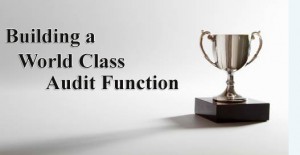Building a World Class Auditing Function
Dictionary.com defines “world class” as ranking among the world’s best. So what does that really mean for an internal audit department? The scope and nature of an auditor’s job varies by organization, size and region. As a result, “world class” is difficult to clearly define. However, there are a few characteristics that can enhance the value an audit function delivers to an organization. I believe these characteristics surround the Personnel, Practices, Perception and Partnerships of the audit function.
Personnel
Business is now moving at the speed of sound. Many organizations are attempting to find new ways to enhance current products and services while exploring new product and service offerings. Additionally, many organizations now find that they must expend efforts on certain processes that have nothing to do with their primary product or service offering. (Please note that the previous statement is in no way indicated that these non core processes are unimportant). For example, there is a lot of effort focused on the overall social media presence and experience. Finally, technology is changing the way many organizations operate.
What this means for audit functions is that they must be able to understand the organizations goals and objectives, have diverse skills and be able to quickly adjust to environmental changes. World class audit function personnel may exhibit some of the following:
- Strategic thinkers
- Continuous training/updating of skills
- Diverse experiences
- Diverse personnel
- Continuous improvement mindset
Practices
The practices of an internal audit function define how it completes its mission. The Institute of Internal Auditors (IIA) sets basic standards by which audit functions should abide. However, the execution of those standards should fit the audit functions environment and align with that environment’s strategy. World class practices include the following:
- Continuous training and development to understand the risks prevalent in the industry and specific to the organization
- Developing a strategic plan tailored to relevant risks
- Active communication with stakeholders throughout the audit process
- Producing relevant, clear and concise reports
- Maintaining effective mechanisms for issue tracking and escalation
- Adhering to standards governing the profession
- Soliciting feedback from stakeholders
- Identifying ways to improve
Perception
No matter how good the people and practices, the unfortunate reality is that an internal audit function is only as good as the perception of its stakeholders. To clarify, an audit function with the most qualified personnel and cutting edge practices may be may be hindered by a stakeholder community that sees no value in its services. Essentially, the function has world class potential, but is blocked from living up to that potential. Maintaining or changing perception is a daunting task. It takes time. But with persistence, you may be able to win over your toughest critics. Good perception practices include:
- Clearly communicate your mission, values and objectives
- Brochure describing your mission, values, objectives
- Website with similar information, but a little more detail
- Now that you’ve communicated what you believe in, walk the talk
- Facilitate informational and/or training sessions
- Solicit feedback from stakeholders (what are their expectations)
- Attempt to manage to those expectations
- Announce that you are a world class audit function
Partnerships
Partnerships with key personnel or functions is an essential element of a world class audit function. The right partnerships can open doors to the inner workings of your organization. In my opinion, partnerships go well beyond endorsements from the C suite. It is also about forming trusted relationships with the “doers” in your organization. Have you ever worked with someone who knew just who to call to get something done in almost any situation. That person had trusted partnerships with others in the organization. Forming partnerships is the most difficult element in building a world class audit function. The difficulty lies in the fact that partnerships rely heavily on the execution of personnel, practices and perception strategies. Without the three of those, strong partnerships may not exist.
In summary, building a world class audit function requires the right personnel, strong practices, a favorable perception and strong partnerships. Any audit function that can achieve these elements should be considered a world class function.
What do you think?
If you like this article, send it to a friend or leave me a comment.
If you do not like this article, send it to a friend or leave me a comment.


Robert,
I very much liked your article as you have presented practice tips in an easy to read manner.
Might you consider submitting a piece for the IIA-Australia Journal. Details can be found on the website. Alternatively, I am happy to take any questions you may have.
Best regards,,
Stephanie Koehn
Journal Staff Editor
Stephanie,
Thank you. I’m glad you found some benefit in the article. I will definitely view the website, contact you with a few questions and submit something for inclusion in the IIA Journal. I look forward to working with the IIA-Australia.
One side note: I have noticed a lot of traffic on this site from many countries including Australia. That’s pretty exciting.
If you like the content, tell a friend (or two) or sign up for the newsletter or the newsfeed.